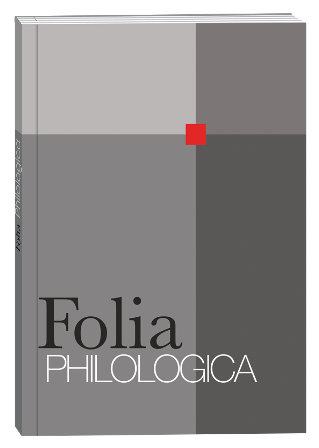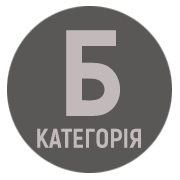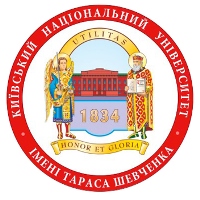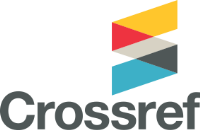ALGEBRAIC SYMMETRY MODELS FOR BALTO-SLAVIC FOLKLORE TEXTS
DOI:
https://doi.org/10.17721/folia.philologica/2021/1/5Keywords:
mathematical modelling, symmetry, fairy tale, composition, narration, East Slavic folklores, Baltic folkloreAbstract
The present article suggests a tool for describing and analyzing the folklore texts' symmetry by introducing basicconcepts of abstract algebra: set theory, group theory, function, equation, and symmetry. The mathematical model showsthe internal homogeneity of folklore texts composition that is valid across the genre boundaries. The compositionallymeaningful entities of different language levels that constitute the core of a compositional pattern can be divided intotwo sets connected by a function of symmetrical reflection. Each element of the first set A is projected onto the elementof the second set B. The set A can be called input, the symmetrical set B – output. On the metrics and rhyme level, it isa constant reiteration of the same pattern reflected ad infinitum. On the level of syntactic order, this function connectssentences that constitute parallelistic structures. Thus, the composition and perception of folklore texts resemblea succession of linguistic equations: a singer introduces independent variables that should be given a specific dependentvariable, which can be chosen only from the thesaurus of elements accepted by a specific folklore tradition. The functionthat associates elements of the input set with the output set is the folklore poetics itself, so it can be defined in a seriesof elementary equations that show the connection between the number of compositionally significant elements and otherproperties of the texts, mainly the type of symmetry that is inherent to a particular text. Though all main types of symmetrycan be detected in the folklore texts, they can be reduced to a basic operation of reiterating a small number of elements belonging to one set, connected by an operation of symmetrical reflection constituting a group of symmetry. Compositionpatterns of seemingly different genres (riddles, ritual songs, cumulative fairytale, magical fairytale) have one fundamentalfeature in common that underlies them: when the enumeration of the input set A is over, the level of freedom for the choiceof the output set B is highly restricted, as each of the linguistic equations (L. Zadeh) should be solved: the hero, onceborn, should be either married or killed, the riddle should be answered traditionally, set of images of human life shouldbe confronted with the set of corresponding images of nature (in ritual songs), etc., thus giving the recipient pleasureof constant reiteration and decipherment of already known patterns. In this case, the new meaning of folklore texts canbe revealed. By introducing repetitive patterns of composition, they introduced elementary classification and logic tools.In this case, phenomena like I Quing turned out to be not an exception but rather a logical continuation of binary logicof folklore text composition, so overtly represented in the Balto-Slavic area but valid for a much broader realm of folkloretraditions.
References
Aleksandrov P. (1980) Vvedenie v teoriyu grupp. Moskva: Nauka.
Anikin V.P. (sost.) Russkie narodnye skazki. Moskva: Pressa. 1992. 560 s.
Afanasev A.N. Narodnye russkie skazki A. N. Afanaseva: V 3 t. T. 1. M: Nauka, 1984.
Baevskiy V. (1995) Volshebnaya skazka kak sredstvo dlya osvoeniya kauzalnykh otnosheniy. Kunstkamera. Etnograficheskie tetradi 8-9, 262-265.
Berezovskiy І.P. (upor.) Zagadki. Kyiv: Dnіpro, 1987. 158 s. 6. Varga B., Dimen Yu., E. Loparits. Yazyk, muzyka, matematika. Moskva: Mir, 1981. 248 s.
Veyl G. (1968) Simmetriya. Moskva: Nauka.
Gilbert D., Kon-Fossen S. Naglyadnaya geometriya. Moskva: Nauka, 1981. 344 s.
Gratsіanska L.M. Narisi z narodnoї matematiki Ukraїni. Monografіya. K. KDU, 1968. 100s.
Griffin M. (2000) Mythic spacetime. Journal of Literary Semantics, 29, 61-74.
Griffin M. (2001) An expanded, narrative algebra for mythic spacetime. Journal of Literary Semantics, 30, 71-82.
Griffin M. (2003) More features of the mythic spacetime algebra. Journal of Literary Semantics, 32, 49-72.
Gritsa S., upor. (1995) Muzichniy folklor z Polіssya u zapisakh F. Kolessi ta K. Moshinskogo. Kiїv: Muzichna Ukraїna.
Gulbe karaliaus pati. Lietuviu̜ liadies pasakos. Vilnius: Vaga, 1980.
Guseynova A., Pavlovskiy Yu., Ustinov V. (1984) Opyt imitatsionnogo modelirovaniya istoricheskogo protsessa. Moskva: Nauka.
Dey O.І. (upor.) Baladi. Kokhannya ta doshlyubnі vzaemini. Kiїv. Naukova dumka. 1987g. 472s
Dey O.І. (upor.) Baladi. Rodinno-pobutovі stosunki. Kiїv Naukova dumka 1988 g. 526 s.
Kaluzhnin L. (1975) Algebry universalnye. V: Glushkov V.M. (otv. red.) Entsiklopediya kibernetiki. Tom 1(s. 88-90). Kiev: Glavnaya redaktsiya ukrainskoy sovetskoy entsiklopedii.
Lietuviu̜ tautosaka (1962) Lietuviu̜ tautosaka: penki tomai. Dainos, 1. Vilnius: Valstybinė Politinės ir Mokslinės Literatūros Leidykla.
Zade L. (1976) Ponyatie lingvisticheskoy peremennoy i ego primenenie k prinyatiyu priblizhennykh resheniy. Moskva: Mir.
Zemtsovskiy I. (1979) Poeziya krestyanskikh prazdnikov. Leningrad: Sovetskiy pisatel.
Ivanov Vyach. Vs. (1978) Chet i nechet: Asimmetriya mozga i znakovykh sistem. Moskva: Sovetskoy radio.
Kabashnіkaў K. i dr. (1977) Belaruskі falklor. Khrestamatyya. Mіnsk: Vysheyshaya shkola.
Kaluzhnin L.A. Grupp teoriya. V: Glushkov V.M. (otv. red.) Entsiklopediya kibernetiki. Tom 1. – Kiev: Glavnaya redaktsiya ukrainskoy sovetskoy entsiklopedii, 1975. S. 245.
Kvіtka-Osnov’yanenko G. (1981) Zіbrannya tvorіv u semi tomakh. T. 3. Kyiv: Naukova dumka.
Kratko (1975) Avtomat. V: Glushkov V.M. (otv. red.) Entsiklopediya kibernetiki. Tom 1 (s. 18-19) Kiev: Glavnaya redaktsiya ukrainskoy sovetskoy entsiklopedii.
Levi-Stros K. (2001) Strukturnaya antropologiya. Moskva: EKSMO-Press.
Mak-Loun R. (1979) Matematicheskoe modelirovanie – iskusstvo prilozheniya matematiki. V: Endryus, Dzh., Mak-Loun, R. (red.) Matematicheskoe modelirovanie (s. 9-20). Moskva: Mir.
Markus S. (1970) Teoretiko-mnozhestvennye modeli yazykov. Moskva: Nauka.
Moskalenko M. (upor.) Ukraїnskі zamovlyannya. Kyiv: Dnіpro, 1993. 307 s.
Permyakov 1988: G.L. Permyakov, Osnovy strukturnoy paremiologii. Moskva 1988.
Poya D. (1975) Matematika i pravdopodobnye rassuzhdeniya. Moskva: Nauka.
Pontryagin L. (1988) Differentsialnye uravneniya i ikh prilozheniya. Moskva: Nauka.
Pontryagin L. (1984) Nepreryvnye gruppy. Moskva: Nauka.
Rieken, E., Lorenz J., Daues A. (2017–). Gebete der Hethiter. Retrieved from: http://www.hethiter.net/txhet_gebet.
Ronelle A. (1995) Propp and Parry: Structure and Performance. Кунсткамера. Этнографические тетради, 8-9,195-197.
Rybakova L. (2012) Sinergeticheskaya folkloristika. Poryadok v khaose folklornogo mikromira. Deti-roditeli. Sistematizirovannoe sobranie tekstov russkikh narodnykh pesen. Moskva: Progress-Traditsiya.
Schöter A. (1998) Boolean Algebra and the Yi Jing. The Oracle: The Journal of Yijing Studies, 2(7), 19–34. Retrieved from: http://linguistics.berkeley.edu/~rscook/zhou1_yi4/schoter-oracle.pdf.
Švābe A. et al. (1952-1956) Latviešu tautas dziesmas, (Chansons populaires lettonnes) volumes I – XII. Copenhagen: Imanta. Retrieved from: https://latviandainas.lib.virginia.edu/.
Stroyk D. (1990) Kratkiy ocherk istorii matematiki. Moskva: Nauka.
Toporov V. N. Chislovoĭ kod v zagovorakh (po materialam sbornika L. N. Maĭkova «Velikorusskie zaklinaniya» V: Sveshnikova T.N. (otv. red.) Zagovornyy tekst. Genezis i struktura. Moskva: Indrik, 2005. S. 194-246
Feferman S. (1971) Chislovye sistemy. Osnovaniya algebry i analiza. Moskva: Nauka.
Folklornі zapisi (1983). Folklornі zapisi Marka Vovchka ta Opanasa Markovicha. Kiїv: Naukova dumka, 1983.
Frid E. (1979) Elementarnoe vvedenie v abstraktnuyu algebru. Moskva: Mir, 1979.
Shvedova N. i dr. (1989) Kratkaya russkaya grammatika. Moskva: Russkiy yazyk.
Shreyder Yu.A. (1971) Ravenstvo, skhodstvo, poryadok. Moskva: Nauka, 1971.
Eyzenshteyn S. (1988) Chet – Nechet. Razdvoenie Yedinogo. V: Rozhanskiy L. (sost.) Vostok – Zapad. Issledovaniya. Perevody. Publikatsii (s. 234-278). Moskva: Nauka.
Vugman N. (2001) Trigrams in the Ancient I Ching Oracle: An Application of Group. Theory Journal of chemical education78(2).
Yasenchuk A., upor. (1987) Baladi. Kyiv: Dnіpro.









